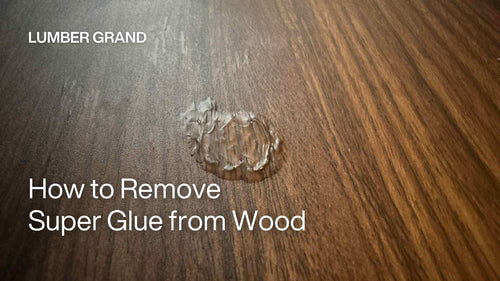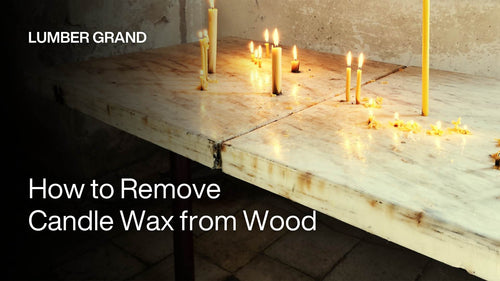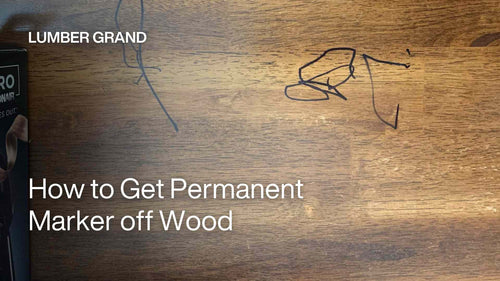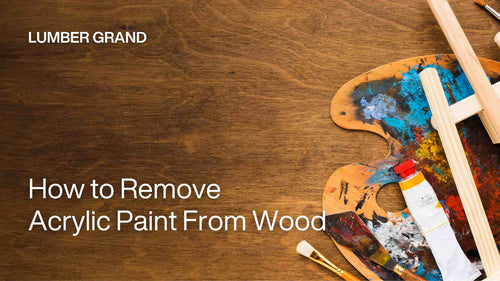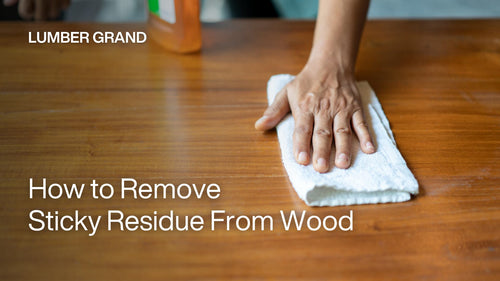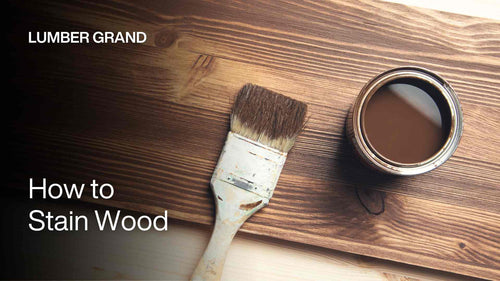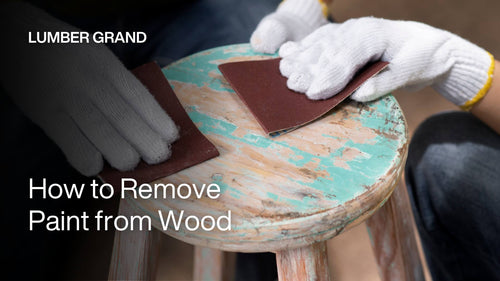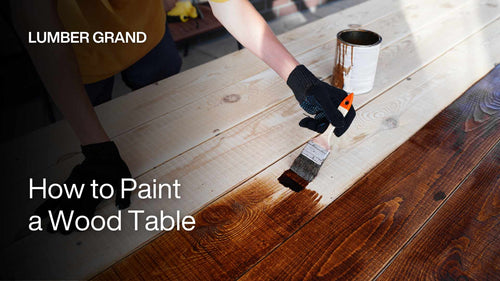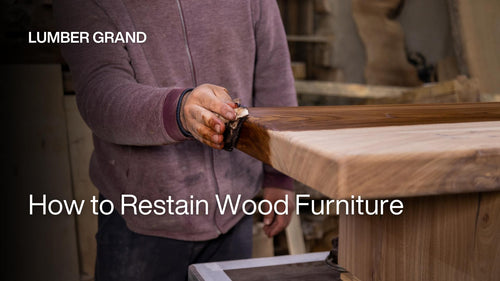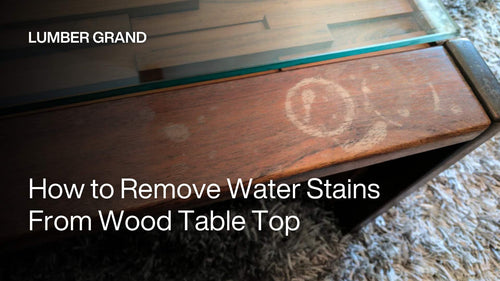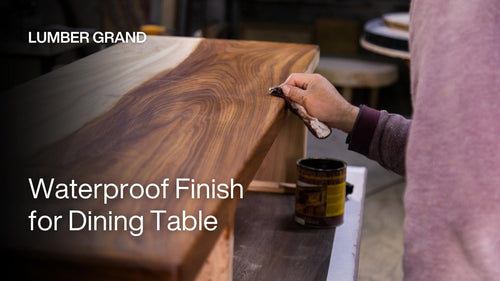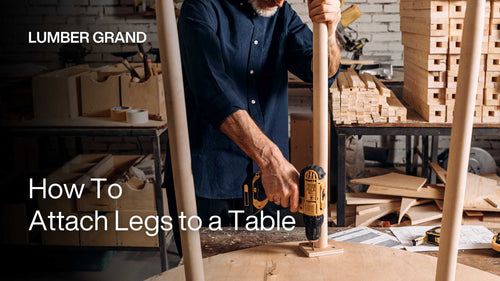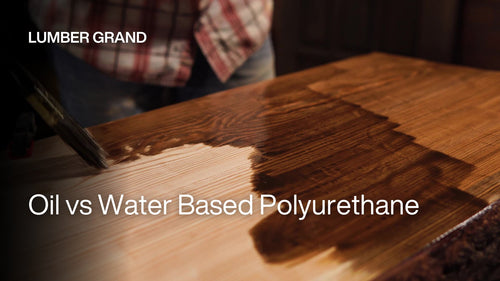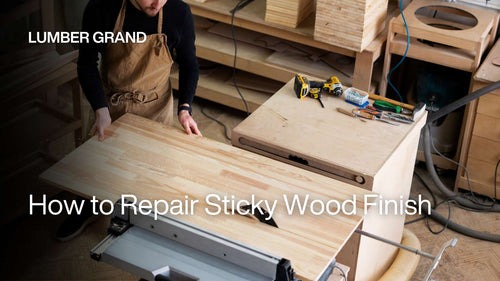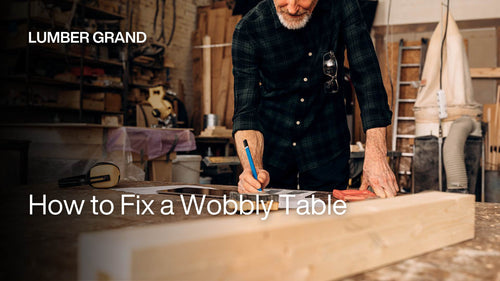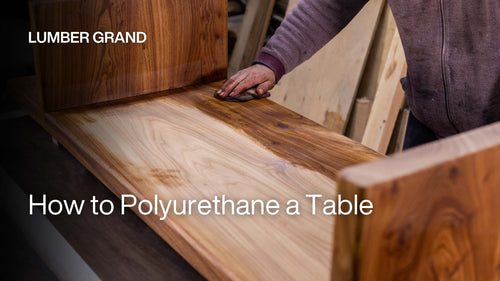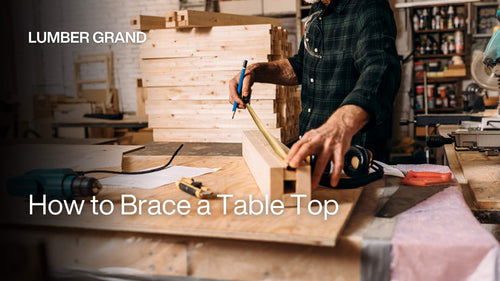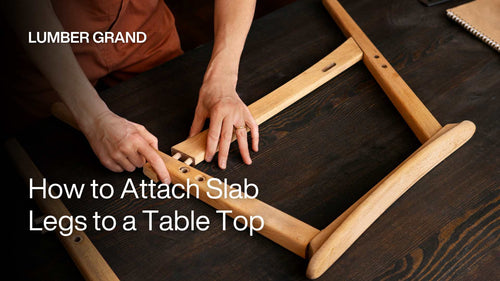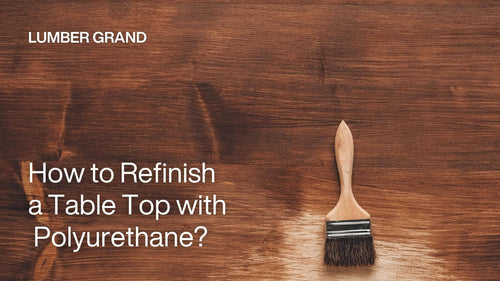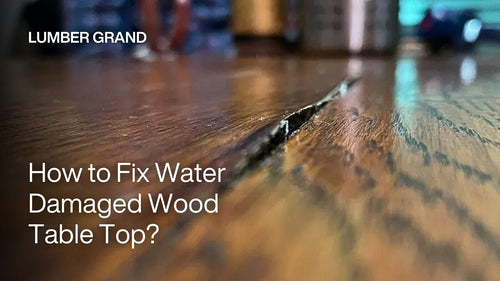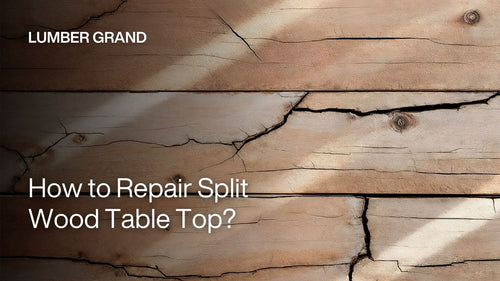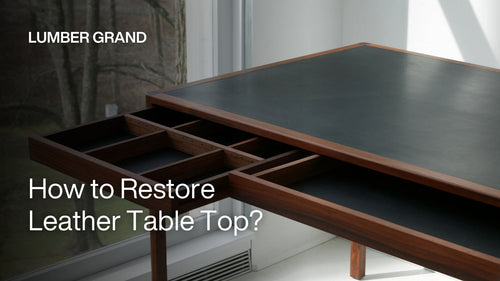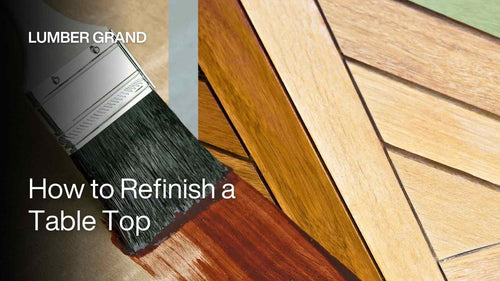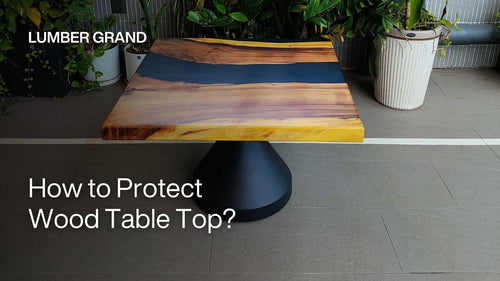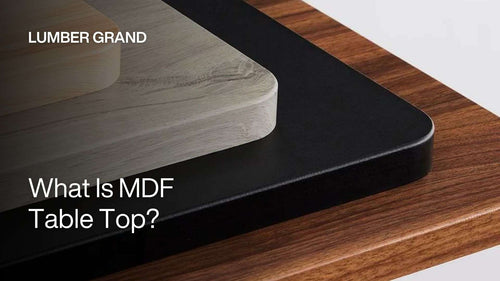How to remove epoxy from wood is tough because that permanent bond is exactly what makes epoxy such a good adhesive in the first place. But tough doesn't mean impossible. Jimmy, our expert who works with metal and wood (and handles epoxy every day), will show you the methods that really work and which ones just waste your time.
This guide covers how to remove epoxy resin from wood using techniques that have been proven to work, from applying heat to scraping it off mechanically. So, no matter if you're dealing with wood tables or cabinets, you'll find something here that works for your situation. Read more!
Why Epoxy is So Hard to Remove
Before we get into the actual epoxy removal methods and what dissolves epoxy, you need to understand what epoxy really is. Epoxy resin is a thermosetting polymer. Once it cures, it forms an incredibly strong, permanent bond with the wood fibers.
Unlike some plastics that can melt, epoxy goes through a chemical reaction while it cures, and you can't just reverse that.

How to remove epoxy resin from wood
Shop now: Round Epoxy Resin Coffee Table 23" Diameter
Credit: Lumber Grand
But epoxy does have a small weak spot: its glass transition temperature (Tg). That's the point where the material gets soft and pliable without actually melting. For most DIY deep-pour epoxies people use for tables and craft projects, you can reach this temperature with common tools like a heat gun.

Meaning of Glass Transition Temperature
Photo: Corrosionpedia
What affects whether you can remove epoxy from wood successfully:
-
Epoxy cure stage: Uncured epoxy is way easier to remove than fully cured epoxy.
-
Epoxy type: Industrial-grade epoxy adhesive is much tougher than what you get at craft stores.
-
Application size: A small glue spot needs a different method than a large table pour.
-
Wood condition: Finished vs raw wood affects how safely you can apply heat.
Safety comes first: As always, Lumber Grand advises working somewhere with good ventilation, wearing safety glasses, and using proper breathing protection. The dust from scraping or sanding epoxy is hazardous. A proper N95 mask isn't optional here.
How to Remove Epoxy from Wood: 3 Proven Effective Ways
Most online guides on how to dissolve epoxy resin promise miracle solutions with household items. After years of working with epoxy professionally, we can tell you that most of those "hacks" are pure fiction. What actually works requires the right approach for your specific situation.
Here's how to choose the best method for your project:
-
Heat works for most epoxy removal jobs, especially on furniture, tables, and large surfaces where you need to soften the bond gradually.
-
Mechanical removal is your best bet when dealing with thick pours or when you're fine with removing some wood thickness along with the epoxy.
-
Chemical methods should be your last option. They're expensive, toxic, and honestly disappointing for most DIY jobs.
Each method works best in different situations. You might even need to combine a few techniques depending on how thick the epoxy is, how long it's cured, and what type of wood you're working with.
Let's start with the approach professionals use most often.
1. Heat Application (Primary Method)
When you heat cured epoxy, you're not melting it. You're just softening it enough that its grip on the wood starts to weaken. It's similar to warming up hard wax. The epoxy gets gummy and pliable so that you can peel or chisel it off in chunks.

Epoxy how to remove
Photo: Shorts | ToolsToday
This is what professionals also recommend for how to remove epoxy glue from wood because it really works. Heat softens the epoxy by raising it to that glass transition temperature we mentioned earlier, which makes it soft enough to chisel away. Chemical methods promise a lot but don't deliver much. Heat gives you reliable results.
What you’ll need:
-
Heat gun (your best option): A quality heat gun gives you controlled, focused heat. It's perfect for removing epoxy from wood cabinets, furniture, or specific spots. Set it to medium-high, around 400 to 500°F to start, and turn it up gradually if you need more heat.
-
Hair dryer (easier on delicate surfaces): For delicate surfaces or thin epoxy layers, try a hair dryer on its highest heat setting. It takes longer, but there's less risk of scorching the wood.
-
Sunlight method (for large surfaces): This is another nifty trick for removing epoxy from wood tables or large slabs. You put the piece outside on a hot day, ideally 85°F or hotter, and wrap it in black plastic.
-
The greenhouse effect can soften the epoxy enough that you can remove it. A woodworker we know used this method successfully on a claro walnut slab table. Just be careful because uneven drying can warp the wood.
-
-
Soldering iron (for precise spots): Press the heated tip directly onto small epoxy spots or along the bond lines when you need surgical precision.
Here is how to remove epoxy from wood with the heat method in 6 steps:
-
Step 1: Set up somewhere with good airflow (outside is best). Grab a sharp chisel, putty knife, safety glasses, and heat-resistant gloves.
-
Step 2: Hold the heat gun 2 to 3 inches from the epoxy. Keep it moving in circles. Never let it sit in one spot, or you'll scorch the wood.
-
Step 3: After 30 to 60 seconds of heating, touch the edge with your chisel. When the epoxy feels gummy instead of rock-hard, you're ready to go.
-
Step 4: Angle your chisel and work in chunks. Heated epoxy should peel away almost like a weak scab. If it's still too hard, heat it more.
-
Step 5: Removing epoxy from wood isn't a race. Work small areas, reheat when you need to, and stay patient.
-
Step 6: Once you've removed the major epoxy, you'll probably have some residue. Light sanding or another pass with heat usually takes care of it.
2. Mechanical Removal (Best Combined with Heat)
Sometimes you just need to remove the epoxy physically. This works especially well for large fills, epoxy flooring, or when you want to know how to remove epoxy from wood without sanding the entire surface.
2.1 Router with Sled
Best for: Large flat surfaces, tabletops, and slabs where you're comfortable removing some wood thickness.
If you're removing epoxy from wood furniture that was filled poorly, a router sled lets you resurface the whole top evenly. Set your depth carefully so you only take off the epoxy and as little wood as possible.
How to remove epoxy from wood with a router sled:
-
Step 1: Build or buy a router sled that spans your workpiece
-
Step 2: Set the cutting depth to just below the epoxy level
-
Step 3: Make multiple shallow passes rather than one deep cut
-
Step 4: Expect to spend time sanding afterward
2.2 Chisel and Scraper Work
Best for: Wood tables or wood cabinets
Hand tools give you precision that power tools just can't match. This matters a lot when you're learning how to remove epoxy from wood tables or wood cabinets and can't risk damaging the areas around it.
We use a sharp chisel at a low angle, almost flat against the wood surface. Apply steady pressure instead of hitting it hard. This works great after you've heated the thick epoxy first. Cold cured epoxy won't budge with just a chisel.
2.3 Dremel and Rotary Tools
Best for: Detail work, cracks, and irregular surfaces where precision matters.
Wire wheel attachments work great for getting into cracks and small voids. A reader dealing with epoxy fills in walnut cracks had good results using a Dremel to remove material from tight spots where chisels couldn't reach.
Like we said earlier, epoxy dust is hazardous. Wear an N95 respirator or better, not just a dust mask. Your lungs will appreciate you later.
3. Chemical Removal Methods (Limited Effectiveness Reality Check)
Most articles claim that acetone, vinegar, or other household chemicals will dissolve epoxy resin. Here's the truth from someone who actually uses these materials professionally. Solvents don't work well on cured epoxy. Period.
A professional boatbuilder puts it this way: "Solvents do not have much effect on cured epoxy, so soaking with acetone or vinegar will only make the air smell bad."
That said, there ARE industrial-grade chemicals that can work, but they come with serious safety concerns and still take a lot of time.
Below is a list of chemicals that actually work (sort of):
3.1 Chlorinated Solvents (Most Aggressive)
Methylene chloride (dichloromethane) is the most effective chemical for dissolving epoxy. Products like ShieldSys™ ES1 contain approximately 100% methylene chloride + Chlorinated solvent-free and can dissolve cured epoxy after several hours of soaking.
Most stripping times should be less than 1 hour of immersion. Heat-cured epoxies, thicker coatings, or chemical-resistant coatings might take up to 12 to 16 hours to completely soften.

How to remove cured epoxy with Methylene Chloride.
Photo: Oregon State University | Environmental Health and Safety
3.2 Specialized Epoxy Removers
Companies like Dynaloy (now part of Versum Materials US LLC) make epoxy removers designed for specific hardener types. Dynasolve cleaner systems remove both cured and uncured urethanes, epoxies, encapsulants, silicones, tapes, dielectric gels, and sealants.
*Safety disclaimer: This information on how to remove epoxy from wood is provided for educational purposes only. Lumber Grand is not responsible for any damages resulting from the use of or reliance on this information, whether direct or indirect, related to any product or application described in this guide.
3.3 Note: Chemicals that Barely Dissolve Cured Epoxy Resin from Wood
-
Acetone: Despite what you read online, acetone barely affects fully cured epoxy. It can help with how to remove uncured epoxy or really fresh applications, but once that epoxy has hardened completely, acetone is pretty much useless. You'll just waste time and money while your workspace smells terrible.
-
One exception: Acetone can slightly loosen epoxy glue bonds after you soak it for a long time (we're talking hours or overnight). That can make mechanical removal a bit easier. But it's just a helper, not the leading solution.
-
-
Vinegar: Forget it. Vinegar does basically nothing to cure epoxy resin. Any article that claims otherwise hasn't actually tried it on a real project.
-
Toluene, MEK, NMP: These industrial solvents work slightly better than acetone, but they still need extended soaking and give you marginal results on fully cured epoxy. The health risks usually aren't worth it for the small benefit.
-
Warm sulfuric acid solution: Technically, this will dissolve epoxy, but it's extremely dangerous. Unless you're a chemist with the right equipment, stay far away from this.
After Removing Epoxy from Wood: What's Next?
Once you've successfully learned how to clean resin epoxy, your wood needs some attention.
-
Check for damage: Look for gouges, scratches, and any epoxy spots left behind. We should be honest about whether the piece can be restored or if it makes more sense to repurpose it into something like cutting boards or shelves.
-
Sand it down: Start with coarser grit, like 80 to 100, if there's significant epoxy residue left. Then work your way up through finer grits — 120, 150, and 220 for a smooth finish.
-
Deal with any voids that are left: If you removed epoxy from cracks and voids, decide whether to leave them natural, fill them with wood filler, or redo them with epoxy the right way this time.
-
Pick your finish: Oil finishes like tung oil or Danish oil give you a natural look, polyurethane finish if you want durability, shellac for traditional furniture, or leave it raw for a rustic feel.
The upside here: Once you've removed badly applied epoxy, you get a second chance to do it right. Or you can just embrace the wood's natural character without any fills at all.
Read more: 5+ Best Finish for Outdoor Wood Furniture
Epoxy Remover Common Mistakes to Avoid
Learning how to get rid of epoxy means knowing what doesn't work, too.
-
Don't expect household solvents to work miracles: Acetone and vinegar won't magically remove cured resin. You'll just waste time and money breathing in toxic fumes.
-
Don't overheat the woo: Heat works, but too much scorches the wood, ruins the finish, and can warp or crack it. Watch for any discoloration and stop immediately if the wood starts to darken.
-
Don't skip your safety gear: Epoxy dust has chemicals you really don't want in your lungs. Heat creates fumes. Chemical removers are toxic. Wear proper respiratory protection, not just a flimsy dust mask.
-
Don't rush it: Trying to chisel away cold, fully cured epoxy with brute force just gouges the wood, damages your tools, and frustrates you. Taking your time with heat saves time overall.
-
Don't do this indoors without ventilation: Heated epoxy and chemical fumes need somewhere to go. Work outside when you can, or make sure you have excellent airflow with fans and open windows.
-
Don't assume all epoxies are the same: Marine-grade epoxy adhesive that boat builders use is way tougher than craft store deep-pour resin. Industrial applications might need professional removal.
FAQs
1. Does Acetone Remove Cured Epoxy from Wood?
No, not effectively. Acetone has minimal impact on fully cured epoxy. It works on uncured or partially cured epoxy, but once the resin is fully hardened on wood furniture, acetone mainly just creates fumes without removing material. Heat works far better for cured epoxy.
2. What Dissolves Hardened Epoxy?
Very few substances can dissolve hardened epoxy well. The most aggressive chemical that works is methylene chloride (dichloromethane). This solvent can be a good choice for how to dissolve cured epoxy resin after several hours of soaking, but it's toxic, and you need to be extremely careful with it.
Other chemicals that have limited success include specialized epoxy removers from companies like Dynaloy, which are designed for specific hardener types.
There's also NMP (n-methylpyrrolidone), an industrial solvent that works moderately well. And warm sulfuric acid solution will dissolve it, but that's highly dangerous and NOT something you should try at home.
3. Can You Remove Epoxy with Rubbing Alcohol?
No, rubbing alcohol (isopropyl alcohol) doesn’t effectively remove cured epoxy from wood. While rubbing alcohol can clean up uncured epoxy that's still wet or tacky, it has virtually no effect on fully hardened epoxy resin.
4. Can Epoxy Be Sanded Off Wood?
Yes, but it's incredibly time-consuming. Epoxy is harder than most wood species, so you'll burn through sandpaper quickly. Combining heat softening with sanding is more efficient than sanding alone. It helps you remove epoxy without sanding the entire surface unnecessarily.
How to Remove Epoxy from Wood Without Sanding: Guide End Here
So, if you're serious about removing epoxy from wood furniture, use heat or mechanical methods first. Save chemicals as a last resort or backup option. The time you'd spend soaking and re-soaking is better spent with a heat gun and chisel.
Sometimes, the best solution isn't spending days fighting the epoxy. If a piece is badly damaged, think about repurposing it into smaller projects. Those cutting boards and shelves might turn out better than what you originally planned anyway.
Besides, if you have questions about “how to remove epoxy from wood”, feel free to reach out to us anytime at Lumber Grand. Thanks for reading!







